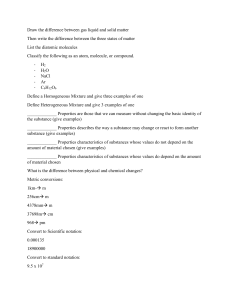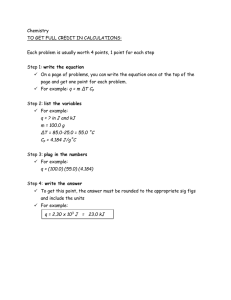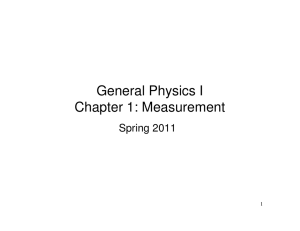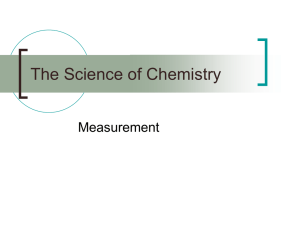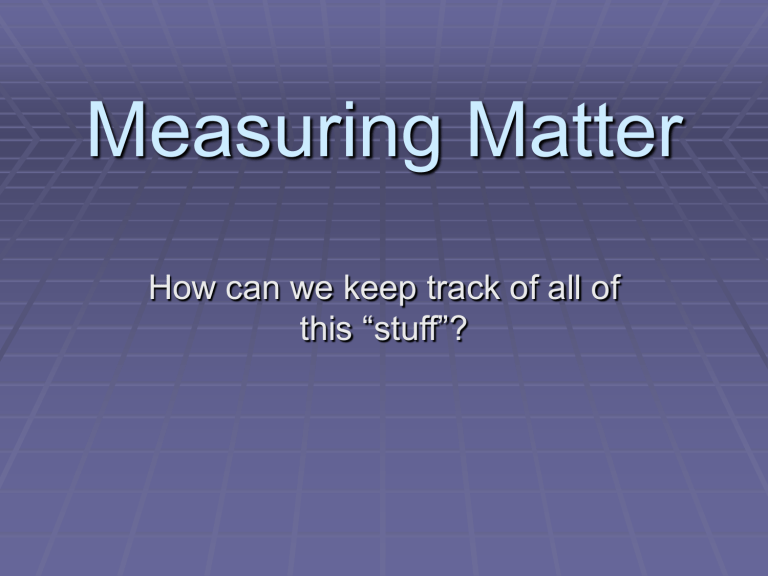
Measuring Matter How can we keep track of all of this “stuff”? Measuring Matter in Two Ways Qualitative Measurements: which are usually descriptive like observations. Now it is important to start making… Quantitative Measurements: are in the form of numbers and units. The Powers of Ten Picture a microscopic cell. Picture the galaxy. Scientific Notation Scientists need a way to express extremely LARGE and extremely SMALL numbers in their quantitative measurement. Scientific notation shows the product of two numbers: A coefficient X 10 to some exponent Scientific Notation Remember that a coefficient is simply a number that you multiply an expression by. **In scientific notation1≤ coefficient <10. Also remember that 10 to some power is simply ten multiplied by itself that many times. Ex. 103 = 10 x 10 x 10 Also, ten to a minus power is dividing by ten that many times. Examples of the use of Scientific Notation I like to run. For every one mile, I have run 1609 meters. Expressed in scientific notation, this is 1.609 x 103 meters When you multiply something times ten THREE times, you move the decimal place to the right three times. More examples The diameter of a human hair is 0.000 008 meters. Expressed in scientific notation that is, 8.0 x 10-6 meters Note: The negative sign moves the decimal place in the other direction. Try some on your own… 45,700 = 4.57 x 104 0.009 = 9.0 x 10-3 24,200,000 = 2.42 x 107 0.000665 = 6.65 x 10-4 Powers of Ten Video Watch the video and complete the section in the packet. Converting to Expanded Form Move the decimal place the number of times indicated by the exponent. To the right if it is positive. To the left if it is negative. Example: 4.5 x 10-2 = 0.045 Try some on your own… 1.2 x 10-4 = 0.00012 9.6 x 103 = 9 600 8.07 x 102 = 807 Multiplying with Scientific Notation Multiply the coefficients Add the exponents Example: (2.0 x 103) x (2.0 x 103) = 4.0 x 106 Dividing with Scientific Notation Divide the coefficients Subtract the exponent in denominator from the numerator. Example: 3.0 x 104 ÷ 2.0 x 102 = 1.5 x 104-2 = 1.5 x 102 Adding & Subtracting with Scientific Notation In order to add numbers written in scientific notation, the exponents must match. Example 5.40 x 103 + 6.0 x 102 = Change 6.0 x 102 to 0.60 x 103, then add. 5.40 x 103 + 0.60 x 103 = 6.00 x 103 Try some on your own… (3.95 x 102) ÷ (1.5 x 106) = 2.63 x 10-4 (3.5 x 102) (6.45 x 1010) = 2.2575 x 1013 (4.44 x 107) ÷ (2.25 x 105) = 1.973 x 102 (4.50 x 10-12) (3.67 x 10-12) = 1.6515 x 10-23 A Short History of Standard Units Humans did not always have standards by which to measure temperature, time, distance, etc. It wasn’t until 1790 that France established the first metric system. The First Metric System The French established that one meter was one ten-millionth of the distance of the from the Equator to the North Pole. One second was equal to 1/86,400 of the average day. Today’s Standards The techniques used today to establish standards are much more advanced than in 1790… One meter is equal to the distance traveled by light in a vacuum in 1/299,792,458 of a second. One second is defined in terms of the number of cycles of radiation given off by a specific isotope of the element cesium. S.I. Units The International System of Units is used ALMOST exclusively worldwide (the U.S. is one the of the exceptions). ALL science is done using S.I. units. The United States’ System of Measurement In 1975, the U.S. government attempted to adopt the metric system with little success. The U.S. currently uses the English System of Measurement. Math Quiz Complete the following: 3 5/6 in. + 8 4/9 in. + 5 2/7 in. = Math Quiz Complete the following: 3.83 cm + 8.44 cm + 5.29 cm = So why S.I.? So why S.I.? Decimals are more “computationally friendly” Multiples of ten Eliminate LARGE numbers by using prefixes Scientifically based Measurements and SI Units Quantitative measurements must include a number AND a unit. Base units are used with prefixes to indicate fractions or multiples of a unit. Try to fill in your table. Base Units Base Unit grams meter Liter Kelvin degrees Celsius mole Symbol g m L K °C mol second ampere candela Joule S or sec A cd J Measures… mass distance volume temperature temperature amount of a substance time electric current light intensity energy Prefixes Prefixes combine with base units to indicate fractions or multiples of a unit. Prefixes Prefix megakiloHectodecaBase Unit decicentimillimicronanopicofemto- Symbol M K H D Meaning d c m µ n p f 10 times smaller than base unit 100 times smaller 1 000 times smaller 1 000 000 times smaller 1 000 000 000 times smaller 1 000 000 000 000 times smaller 1 000 000 000 000 000 times smaller 1 000 000 times larger 1 000 times larger 100 times larger 10 times larger than base unit SI Prefixes 1 000 000 000 000 000 000 000 000 1 000 000 000 000 000 000 000 1 000 000 000 000 000 000 1 000 000 000 000 000 1 000 000 000 000 1 000 000 000 1 000 000 1 000 100 10 0.1 0.01 0.001 0.000 001 0.000 000 001 0.000 000 000 001 0.000 000 000 000 001 0.000 000 000 000 000 001 0.000 000 000 000 000 000 001 0.000 000 000 000 000 000 000 001 yottazettaexapetateragigamegakilohectodecadecicentimillimicronanopicofemtoattozeptoyocto- Y Z E P T G M k h da d c m µ n p f a z y More Details: Length meters centimeters (for smaller units of length) millimeters (very small units of length) kilometers (for large units of length) These are the most commonly used. More details: Mass gram kilogram Measured using balances. More details: Volume liters milliliters (for small volumes) microliter (for extremely small volumes) Measured using a graduated cylinder, pipet or buret (more accurate), volumetric flask or even a syringe. Volume is a derived units… Some metric units are derived from S.I. units. Volume is L x W x H = cm x cm x cm = cm3 One cm3 is the same as one mL. Also, dm x dm x dm = dm3 One dm3 is the same as one L. Conversions Using Factor Label Method Multiplying any number by an equality does NOT change the value. An equality is two measurements that are equal in amount but have different units and numbers. Examples: one dozen bagels = 12 bagels 10 mm = 1 cm Steps of Factor Label Method 1. Write down the units you are given. 2. Write X and a Line. 3. Write unit you want to cancel on the bottom of the line, the unit you want to keep on the top of the line. Find and plug in your equality. (hint: the larger unit will always get a 1 next to it) 4. Cancel units and do the math. 5. Voila! Let’s do one together… 0.600L = _______mL 1000 mL 0.600L X = 600 mL 1 L 1 L = 1000mL TRY THE REST ON YOUR OWN !!!! Temperature Scales There are three temperature scales in use in this country that you need to be familiar with. Temperature: A measure of the average kinetic energy of the particles in a sample. Fahrenheit 18th-century German physicist Daniel Gabriel Fahrenheit Based his scale on an ice-salt mixture and normal body temperature Freezing point for water = 32°F Boiling point for water = 212°F Celsius Scale Swedish guy, Anders Celsius in 174 Freezing point at 0°C. Boiling for water at 100°C. Below 0 is negative. Kelvin Scale English guy, William Kelvin Measures molecular movement Theoretical point of ABSOLUTE ZERO is when all molecular motion stops (no negative numbers) Divisions (degrees) are the same as in Celsius Absolute Zero Theoretical point where there is absolutely no movement of molecules in matter and a measure of ZERO ENERGY This is not something that we ever witness, scientists have only theorized this point Conversion Factors You need to know these conversion factors! K = °C + 273 °C = K – 273 On Table T NOT on Table T Practice Conversion Problems Room temperature is approximately 23°C. What is this temperature in Kelvin? Ethanol has a boiling point of 351 K. That won’t help us if we have a thermometer reading degrees Celsius, so convert it. Work on the conversion problems in your packet… Uncertainty in Measurement Uncertainty in Measurement No measurement can be perfect. Scientists need to account for some degree of uncertainty in measurements. Refer to terms accuracy and precision. An ideal measuring device is accurate and precise and does not have a great deal of uncertainty. Accuracy Accuracy is when you are close to the actual value of what you are trying to measure (For example you throw three darts and they are all close to the bull’s eye). Precision Precision is a measure of how close each measurement is to the others. For example if you are at the driving range and all of the golf balls head towards the pond, that is precision (but not accuracy). Uncertainty in Measurement Uncertainty occurs in every measurement made and must be accounted for. In chemistry, we use different tools, each of which has certain limitations. We use the ± to indicate uncertainty in measurement. Uncertainty Equation YOU MUST MEMORIZE THIS EQUATION AS YOU WILL PERFORM IT ALMOST DAILY! ΔF = (δF / δX1) ΔX1 + (δF / δX2) ΔX2 + …(δF / δXn) ΔXn Just Kidding! However, there is a system we use in chemistry that helps to minimize uncertainty by only including those values that have certainty and one that is uncertain. We call them SIGNIFICANT FIGURES! Using Significant Figures Why are significant figures important? Have you ever multiplied two numbers and come up with a really LONG decimal? Well, those numbers are INSIGNIFICANT with respect to scientific calculations. And now for a short story… Counting Sig Figs The Atlantic-Pacific Rule If the decimal is Absent (A), start counting on the Atlantic (right) side. Go to the first NON-zero number and count everything after that. If the decimal is Present (P), start counting on the Pacific (left) side. Go to the first NON-zero number and count everything after that. Quick Self-Assessment How many sig figs are in each of these numbers: 98,000 m 0.123 L 0.00073 L 8765 cm 40,506 m 20.00 mL More Practice Round each number to the number of sig figs shown in parentheses. 314.721 m (4) 0.001775 m (2) 8792 m (2) Sig Figs in Calculations When adding or subtracting measurements, report to the LEAST number of DECIMAL PLACES. For example: 12.52 + 349.0 + 8.24 = 369.76 You will report this with one decimal place as 369.8. Sig Figs in Calculations When multiplying or dividing measurements, you want to report the answer with the same number of sig figs as the measurement with the least number of sig figs. For example: 7.55 m x 0.34 m = 2.567 square meters You will report this with 2 sig figs as 2.6 square meters because 0.34 m contains 2 sig figs. Percent Error in Experimentation When trying to determine how accurate your experimental value (“what you got in the lab”) is compared with the theoretical (“what it is supposed to be”), we use a simple formula. experimental – theoretical x 100% theoretical Theoretical VS Experimental % Example of Percent Error % When you calculate the density of chemical X experimentally you get 1.13 g/mL. The actual density according to the literature is 1.16 g.mL. What is your percent error? Density Density is a derived unit which is found by dividing a substances mass by its volume. Density Equation D=M/V Common Units = g/mL or g/cm3 Density Practice Problems 1. A student measures the mass of a piece of metal to be 4.0g and it has a volume of 1.5mL what is the density of this metal? 2. The Density of CO2 gas is 1.8 grams per liter. What is the mass of 0.2L of CO2 gas?
